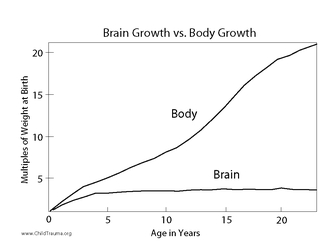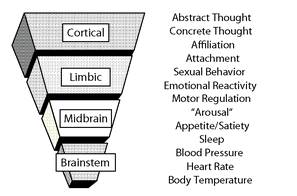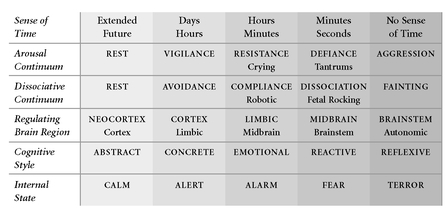The Boy Who Was Raised as a Dog (36 page)
Read The Boy Who Was Raised as a Dog Online
Authors: Bruce Perry

Unfortunately, that basic sense of fairness and goodwill toward others is under threat in a society like ours that increasingly enriches the richest and abandons the rest to the vagaries of global competition. More and more our media and our school systems emphasize material success and the importance of triumphing over others both athletically and in the classroom. More and more, in an atmosphere of increased competitiveness, middle- and upper-class parents seem driven to greater and greater extremes to give their offspring whatever perceived “edge” they can find. This constant emphasis on competition drowns out the lessons of cooperation, empathy and altruism that are critical for human mental health and social cohesion.
I have often been asked to help develop a mental health response following traumatic events that I believe are direct results of a fractured community and our unrelenting focus on competition. Some of the most distressing of these have been school shootings. What I've found time and again in these cases is a winner-takes-all school culture, where bullying is pervasive and accepted and where the “losers” are not considered people who need understanding and support, but utterly deserving of their alienation and exclusion. In these situations it is not only the teenagers who have built and enforced a strict social hierarchy that causes unmitigated misery for those on the bottom, but also the teachers, parents and school administrators. Humans have always been a hierarchical species, of courseâthat's another part of our biologyâbut when you emphasize merciless competition at the expense of all else, in
a culture that glorifies violence, an occasional violent uprising by those who feel left out is hardly surprising. I don't believe we will be able to prevent these incidents unless we work much harder to ensure all students feel included in their school community.
a culture that glorifies violence, an occasional violent uprising by those who feel left out is hardly surprising. I don't believe we will be able to prevent these incidents unless we work much harder to ensure all students feel included in their school community.
Â
THE BRAIN DEVELOPS over time, with a constant accretion of repetitions and exposures; each moment is a chance to reinforce either positive or negative patterns. Once a pattern is started, it becomes like a groove or a rut, making similar behavior easier, more likely to be repeated. The mirroring systems of our social brains make behaviors contagious. And again, this is wonderful when what you are practicing is sports or piano or kindness, but not so great when what's being repeated is impulsive, aggressive responses to threat. I think again about Leon and how, after he began to be neglected, repeated, in themselves unimportant and small decisions came together and made bad behavior increasingly easy for him to choose and put good choices further and further out of his reach.
As a result of this property of the brain, earlier intervention is almost always better than later. But it has to be the right intervention. In Leon's case much of what was done to “help” him actually served to make things worse. When children start to misbehave our initial impulse to punish and deprive them often serves us poorly; we tend to see children who are whiny and demanding and aggressive as “spoiled” and “indulged,” rather than recognizing that these qualities usually arise from unmet needs and unexplored potential, not from having too much or feeling too good. In order for a child to become kind, giving and empathetic, he needs to be treated that way. Punishment can't create or model those qualities. Although we do need to set limits, if we want our children to behave well, we have to treat them well. A child raised with love wants to make those around him happy because he sees that his happiness makes them happy, too; he doesn't simply comply to avoid punishment. These positive feedback loops are every bit as powerful as the negative ones, but they rely upon the sometimes counterintuitive response of first figuring out what
drives misbehavior, then dealing with it, rather than acting first. I fully believe that if Leon had been reached early in his childhood, even if he'd already experienced some neglect by his mother, he would not have become the coldhearted murderer I met.
drives misbehavior, then dealing with it, rather than acting first. I fully believe that if Leon had been reached early in his childhood, even if he'd already experienced some neglect by his mother, he would not have become the coldhearted murderer I met.
However, working with children who have experienced the kind of early trauma that affected Connor, Peter, Justin, Leon and Laura requires two things that are often in short supply in our modern world: time and patience. Traumatized children tend to have overactive stress responses and, as we've seen, these can make them aggressive, impulsive and needy. These children are difficult, they are easy to upset and hard to calm, they may overreact to the slightest novelty or change and they often don't know how to think before they act. Before they can make any kind of lasting change at all in their behavior, they need to feel safe and loved. Unfortunately, however, many of the treatment programs and other interventions aimed at them get it backwards: they take a punitive approach and hope to lure children into good behavior by restoring love and safety only if the children first start acting “better.” While such approaches may temporarily threaten children into doing what adults want, they can't provide the long-term, internal motivation that will ultimately help them control themselves better and become more loving toward others.
Troubled children are in some kind of painâand pain makes people irritable, anxious and aggressive. Only patient, loving, consistent care works; there are no short-term miracle cures. This is as true for a child of three or four as it is for a teenager. Just because a child is older does not mean a punitive approach is more appropriate or effective. Unfortunately, again, the system doesn't tend to recognize this. It tends to provide “quick fixes,” and when those fail, then there are long punishments. We need programs and resources that acknowledge that punishment, deprivation and force merely retraumatize these children and exacerbate their problems.
One of the greatest lessons I've learned in my work is the importance of simply taking the time, before doing anything else, to pay attention
and listen. Because of the mirroring neurobiology of our brains, one of the best ways to help someone else become calm and centered is to calm and center ourselves firstâand then just pay attention.
and listen. Because of the mirroring neurobiology of our brains, one of the best ways to help someone else become calm and centered is to calm and center ourselves firstâand then just pay attention.
When you approach a child from this perspective, the response you get is far different from when you simply assume you know what is going on and how to fix it. When I first approached Justin in his crib/cage, for example, I got a very different response than previous visitors had because I calmly recognized that underneath his frightening behavior was his own fear and hunger. Obviously it is difficult to have this kind of detachment when it is your own child who is misbehavingâespecially when he's doing something that has made you angry or upsetâbut the more you try to see the world from the child's point of view and the safer you make him feel, the better his behavior is likely to be and the more likely you are to find ways of further improving it.
Another important implication of our mirrored biology is that concentrating children with aggressive or impulsive tendencies together is a bad idea, as they will tend to reflect and magnify this, rather than calming each other. Although research demonstrates the negative results of such grouping, we have unfortunately gotten into the habit of organizing therapy groups and residential programs in ways that concentrate such children. As we saw in Leon's case, it can actually serve to make problems worse.
I also cannot emphasize enough how important routine and repetition are to recovery. The brain changes in response to patterned, repetitive experiences: the more you repeat something, the more engrained it becomes. This means that, because it takes time to accumulate repetitions, recovery takes time and patience is called for as these repetitions continue. The longer the period of trauma, or the more extreme the trauma, the greater the number of repetitions required to regain balance.
Also, because trauma at its core is an experience of utter powerlessness and loss of control, recovery requires that the patient be in charge of key aspects of the therapeutic interaction. Over and over again the research finds that if you use force, if you push people to open up when
they aren't ready, if you require participation in therapy, if you don't respect individual differences, then your treatment can actually do serious harm. Because safety is critical to recovery and force creates fear, coercive therapies are dangerous and ineffective for victims of trauma. Trauma tends to drive other mental health problems like many teen behavior problems and an enormous percentage of addictions. Unfortunately, coercive forms of treatment are common in these areas, and this is yet another case in which our efforts to deal with a problem may actually exacerbate it. We need to educate both parents and professionals about these truths, and also work to ensure that the justice system, foster care system and child welfare and mental health care systems use evidence-based approaches that at the very least are informed by knowledge about trauma and reduce, rather than increase, harm.
they aren't ready, if you require participation in therapy, if you don't respect individual differences, then your treatment can actually do serious harm. Because safety is critical to recovery and force creates fear, coercive therapies are dangerous and ineffective for victims of trauma. Trauma tends to drive other mental health problems like many teen behavior problems and an enormous percentage of addictions. Unfortunately, coercive forms of treatment are common in these areas, and this is yet another case in which our efforts to deal with a problem may actually exacerbate it. We need to educate both parents and professionals about these truths, and also work to ensure that the justice system, foster care system and child welfare and mental health care systems use evidence-based approaches that at the very least are informed by knowledge about trauma and reduce, rather than increase, harm.
Â
OF COURSE, MAKING our world safer for children won't be easy. Efforts to do so must address some of the largest political controversies of our time: globalization, the “mommy wars,” economic inequality, to name just a few. And the United States has historically done little more than give lip service to children's issues, with both parties raising the banner of “family values” while doing little to actually address the day-to-day problems affecting most parents and children. I don't have all the answers. But I do think that understanding ourselves as a social species, with a brain that evolved with certain unique capacities and weaknesses, a brain that becomes what it practices, will allow us at least to ask the right questions. And that is the best place to start when seeking to build a loving, caring community.
Appendix

FIGURE 1.
Growth of the Body and the Brain.
Growth of the Body and the Brain.
The physical growth of the human body increases in a roughly linear manner from birth through adolescence. In contrast, the brain's physical growth follows a different pattern. The most rapid rate of growth takes place in utero, and from birth to age four the brain grows explosively. The brain of the four-year-old is 90 percent adult size! A majority of the physical growth of the brain's key neural networks takes place during this time. It is a time of great malleability and vulnerability as experiences are actively shaping the organizing brain. This is a time of great opportunity for the developing child: safe, predictable, nurturing and repetitive experiences can help express a full range of genetic potentials. Unfortunately, however, it is also when the organizing brain is most vulnerable to the destructive impact of threat, neglect and trauma.
However, this early pattern of brain growth does not mean that development or organization of the brain is finished. Indeed, important neurodevelopmental processes continue to take place throughout childhood and adolescence as the brain's systems become more complex. Major cortical restructuring and myelination continue into early adult life.

FIGURE 2.
Hierarchy of Brain Function.
Hierarchy of Brain Function.
The human brain develops sequentially in roughly the same order in which its regions evolved. The most primitive, central areas, starting with the brainstem, develop first. As a child grows, each successive brain region (moving out from the center toward the cortex), in turn, undergoes important changes and growth. But in order to develop properly each area requires appropriately timed, patterned, repetitive experiences. The neurosequential approach to helping traumatized and maltreated children first examines which regions and functions are underdeveloped or poorly functioning and then works to provide the missing stimulation to help the brain resume a more normal development.

Other books
The Rock Child by Win Blevins
Crazy Hot by Tara Janzen
A History of the Wife by Marilyn Yalom
A Scandalous Proposition by George, MM
DeliciousDanger by Desiree Holt
The Laws of our Fathers by Scott Turow
Murder of a Sweet Old Lady by Denise Swanson
Witness Protection: Hide and Seek by Dukes, Ursula
Coming Home to You by Fay Robinson
Hirohito and the Making of Modern Japan by Herbert P. Bix
